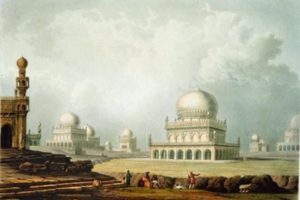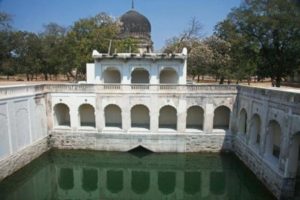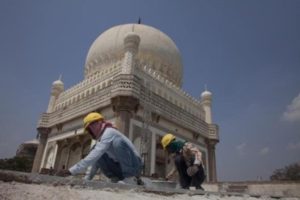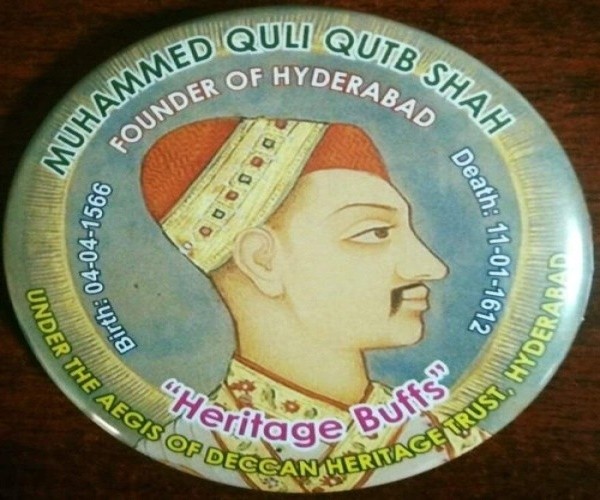The Aga Khan Trust for Culture’s ongoing restoration of the Qutb Shahi necropolis in Hyderabad is one of the most ambitious conservation projects undertaken in India.
…the Kingdom of Golconda may be said to be the country of diamonds…The castle where the King commonly keeps his court… it is called Golconda and the Kingdom bears the same name…he called it Golconda, from the word, Golear, which in the Telenghi language signifies a shepherd.
The sepulchers of the King who built Golconda and the five Princes who have reigned after him…they take up a great deal of ground, because every one of them is in a large garden…the tombs…of the kings…some are lined with that lovely stone…others with black stone and others with white, so varnished as that they appear to be polished marble…the tomb of the King that died last is the finest of them all and its dome is varnished over with green… —The Travels Of Monsieur De Thevenot Into The Levant, 1687
India in the 17th century was a fascinating land for travellers like Jean de Thévenot. There was the opulence of the Mughal courts, the bounty of natural resources and the siren call of a culture far removed from that of the West. Contributing to the temptation were the mines of Golconda, at the time the only place in the world where diamonds were found. In fact, two centuries after Thévenot visited India, the Oxford dictionary would define Golconda as a “source of wealth, advantages or happiness”.
 This, however, is not a story of those mines or the fabulous stones they yielded—and which, incidentally, still occasionally dominate political debate—but of the kings that once ruled Golconda, before the nizams and the British established their authority over the region.
This, however, is not a story of those mines or the fabulous stones they yielded—and which, incidentally, still occasionally dominate political debate—but of the kings that once ruled Golconda, before the nizams and the British established their authority over the region.
Famed patrons of the arts, their kingdom a centre of confluence for cultures as varied as Persian and Dakkhani, the Qutb Shahis were contemporaries of the Mughals. They ruled parts of present-day Andhra Pradesh, Telangana and Tamil Nadu from 1512 until 1686-87, when Aurangzeb conquered Golconda. History doesn’t have much patience for those who lose; the victor walks away with the right to shape the narrative, while the vanquished is banished to the sidelines. The fate of the Qutb Shahis was no different.
Even as Hyderabad, the city they had established, flourished, and Charminar, the iconic monument built by the fifth king, Muhammad Quli Qutb Shah, to commemorate the eradication of a plague, became one of India’s most recognizable symbols, the Qutb Shahis themselves faded from public memory.
Yet, there is one reminder of their existence that had never really found its place in the spotlight, until now. This is a necropolis that lies at the foothills of the famous Golconda Fort, where all but the last ruler of the dynasty are buried, their tombs a testament to the rise and fall of the empire. Now, four centuries after the eighth and last ruler, Abul Hasan Tana Shah, lost the war to Aurangzeb in 1686-87 and the Qutb Shahis were plunged into obscurity, there is an attempt to bring them back to life, through the very monuments that commemorate their death.
April in Hyderabad can be merciless as the temperature climbs to 40 degrees Celsius and above. Five years ago, a team of at least a dozen architects braved this heat, heading towards Ibrahim Bagh, or the Qutb Shahi Heritage Park as it is now known, where the tombs are located. They would remain in the city till July, making over 2,000 drawings of the tombs, and poring over archival material, such as the oldest-known photographs sourced from different places such as the Alkazi Foundation, Canadian Centre for Architecture and British Library, etc. They were there to carry out a site assessment, which included a detailed documentation of every monument at the park.
The architects were from the Geneva-based Aga Khan Trust for Culture (AKTC), one of the agencies of the Aga Khan Development Network, a family of institutions created by Aga Khan. The AKTC is a philanthropic foundation that focuses on the social, cultural and economic revitalization of communities in different parts of the world. Its involvement with India dates back to 1997, when it undertook the garden restoration at Humayun’s Tomb in New Delhi. Their second conservation project on Humayun’s Tomb was the result of a public-private partnership between the AKTC and several state agencies, including the Archaeological Survey of India (ASI). Today Humayun’s Tomb attracts almost two million visitors annually.
At the Qutb Shahi tombs in 2012, the AKTC was working on the initial documentation and assessing the condition before inking a memorandum of understanding (MoU) in January 2013 with the government of erstwhile Andhra Pradesh—and now honoured by the government of Telangana—to restore the tombs to their previous glory. This is only the second public-private conservation-related MoU signed in India.
For the AKTC, it was a chance to work on a site of architectural significance; for the government, it was the perfect opportunity to carve out a distinct identity for the new state.
Telangana’s pride
The locals have their own name for the Qutb Shahi Heritage Park—saat maqbara, referring to the tombs of the seven kings here, but the 106-acre park actually consists of 75 monuments, including 40 mausoleums, 23 mosques, six baolis (step-wells), a hamam (Persian bath), pavilions and garden structures. Some of the tombs rival Mughal gems like the Humayun’s Tomb and the Taj Mahal in scale. It is perhaps the only necropolis where one can see the evolution of an architectural style during the reign of a dynasty, from Iranian influences to elements of Vijayanagara architecture.
So, neither the AKTC nor the Telangana government are off the mark in hoping that when the conservation project is finally completed, people will visit Hyderabad just to see it. “There have been few conservation projects in India that have been consequential at a city scale. This is one of them. The Qutb Shahi project actually touches the core of Hyderabad’s identity,” says K.T. Ravindran, a well-known urban planner and a former dean of the School of Planning and Architecture in New Delhi.
The park has already been nominated for Unesco World Heritage Site status. With a multidisciplinary team of architects, civil engineers, archaeologists and master craftsmen working round the clock, and generous donations from benefactors like the Tata Trust and others, this is also arguably one of the most ambitious conservation projects undertaken in India.
“There is no equal to this site in the world…it is very important for this project to succeed,” says N.R. Visalatchy, director, department of archaeology and museums, Telangana government, over the phone from Hyderabad. Emphasizing the importance of historical monuments in creating Telangana’s identity is the state’s emblem, which has an image of the Kakatiya Kala Thoranam, a historical arch in Warangal district, with the Charminar within it.
The MoU tasks the AKTC with the conservation work, albeit under the aegis of the state’s department of archaeology. “There are two kinds of public-private partnerships. One is where the responsibility is shared; the other—which is this one—is where we, the government, provide administrative (and) legal support while the trust carries out the conservation,” Visalatchy explains.
One of the most important tombs in the Qutb Shahi Heritage Park—that of the founder, sultan Quli Qutb-ul-Mulk—is also interestingly one of the smallest in the complex. Before founding his empire, Quli Qutb-ul-Mulk served in the Bahmani Sultanate, the first independent Muslim kingdom in south India. He had migrated from Persia to Delhi in the early 16th century before making his way to the Deccan. Quli Qutb declared independence and staked claim to Golconda when the Bahmani Sultanate disintegrated in the early 16th century, taking on the title of Qutb Shah.
Situated in the southern part of the park, 12 minarets with crenellations flank the dome of his tomb; the base is adorned with petals. Archival images dating back to 1860, sourced from the Alkazi Foundation for the Arts—a trust dedicated to the preservation of cultural history—show a monument with ornate lime stucco works on walls, arches crowned with medallions, circular decorative panels and ribbed plaster on the minarets. But the monument that the AKTC’s team got to work with was covered in a layer of cement plaster, with hardly any details visible. The dome had been completely blackened by algae, vegetation was growing on it, and the walls were covered with graffiti.
“We removed cement which was at least 8 inches thick, (and) all the original details were obliterated,” explains Ratish Nanda, chief executive officer, AKTC India, when we meet at the Qutb Shahi Heritage Park in early March. For over a year during 2014-16, two dozen craftsmen worked to restore the patterns on the monument wherever possible. Layers of cement, plastered on sometime during the 19th century, were removed, revealing underlying details like patches of intricate filigree work in the medallions. These patterns were eventually restored.
“This is the tomb of the founder of the dynasty, he is the reason why the whole necropolis is here, and as such it was very important,” says Nanda.
It is believed that craftsmen from Iran worked on the tomb. “The tomb of sultan Quli Qutb-ul-Mulk is more or less in the same style as that of the Bahmanis. But with the later tombs we clearly see how the kingdom of Golconda started establishing an identity of its own vis-à-vis architecture. The tomb of Jamsheed, Quli Qutb-ul-Mulk’s son and successor, is an attempt at this. It has an octagonal dome and sloping walls,” says Hyderabad-based historian Sajjad Shahid.
In fact, according to Shahid, the idea of a necropolis, too, could have been adapted from the Bahmanis. “Their structures were in rows but the Qutb Shahis chose gardens to enclose their tombs. This can be seen as yet another attempt to establish their identity, separate from their erstwhile rulers.”
The architecture in the necropolis is a blend of Persian and Hindu styles. It is interesting to draw comparisons between Mughal and Qutb Shahi architecture, seeing that some of the greatest Mughal monuments were being built in the same period. While the Mughals worked mostly with sandstone and marble, adorning this with intricate carving, the Qutb Shahis used granite that was available locally. “Granite is hard to work with, so though the core construction was with granite, facings were done with stone dressings,” explains Yoshowant Purohit, project manager, AKTC.
The larger tombs in the park have arcaded verandas, while the parapets have crenellations. The domes are capped with lotus petal-like designs and, in some cases, have diamond-shaped bands with medallions, and patterns that run along the base, etc. The tomb of Subhan, the son of Jamsheed, who ruled for only a few months when he was still a minor before being deposed by his uncle, Ibrahim, also has extensive lime-plaster details, with elements like pineapples and squirrels.
In the three years since conservation work started, the AKTC has restored 15 structures, including the Badi Baoli, the largest step-well in the complex. It is currently working on 15 more monuments, including the tomb of Muhammad Quli Qutb Shah, the founder of Hyderabad. The work is being carried out in three phases, ensuring that at any given point, at least 75% of the park remains open to the public.
Art of restoration
Conservation seeks to remind us of what once was, but behind the romanticization lies a careful science. The first step in a conservation project is a detailed study of the site, including an assessment of the condition of monuments. This includes high-resolution photography as well as laser scanning for accurate architectural documentation, and a detailed 3D scanning of the monument. Laser beams are bounced off the building to create an accurate data set, which is used to create solid 3D models. All the tombs in the necropolis underwent this process.
 The next step is writing out a conservation note. In 2012, most of the monuments in the park bore visible signs of extensive damage. The dome of Jamsheed’s tomb, for instance, had a crack, and the plinth of the platform of another was collapsing. But the one monument in urgent need of attention was the Badi Baoli, one of the six large water reservoirs within the park. They were probably built to store water to irrigate the orchards surrounding the tombs. In 2013, heavy rain damaged the western façade of the Badi Baoli; it caved in completely, with 450 cubic metres of masonry (that’s equivalent to almost 100 truckloads) collapsing. “Collapsed stone beds were removed from the bed of the baoli and reused in repairs. Earlier this year, on 3 January, we opened the baoli to the public after three years because that’s the time it has taken to rebuild it. It goes 60ft deep and holds 30 lakh (3 million) litres of water,” explains Nanda, even as he marvels at the school of fish that has sprung up in the step-well.
The next step is writing out a conservation note. In 2012, most of the monuments in the park bore visible signs of extensive damage. The dome of Jamsheed’s tomb, for instance, had a crack, and the plinth of the platform of another was collapsing. But the one monument in urgent need of attention was the Badi Baoli, one of the six large water reservoirs within the park. They were probably built to store water to irrigate the orchards surrounding the tombs. In 2013, heavy rain damaged the western façade of the Badi Baoli; it caved in completely, with 450 cubic metres of masonry (that’s equivalent to almost 100 truckloads) collapsing. “Collapsed stone beds were removed from the bed of the baoli and reused in repairs. Earlier this year, on 3 January, we opened the baoli to the public after three years because that’s the time it has taken to rebuild it. It goes 60ft deep and holds 30 lakh (3 million) litres of water,” explains Nanda, even as he marvels at the school of fish that has sprung up in the step-well.
However, while modern technology can help conservation, and architects can pinpoint the repairs needed, the actual physical work relies on India’s building craft, which is said to go back at least 3,000 years. Conservation architects and experts will tell you that they are fortunate to still have traditional craftsmen, carvers, masons, etc., in India, though the numbers have reduced greatly. In fact, the ASI’s National Policy for Conservation of the Ancient Monuments, Archaeological Sites and Remains, 2014, states, “India is privileged to benefit from the continuing existence of traditional masons, craftspersons, carvers… who pursue their traditional practices in different parts of the country. They practise pre-modern traditions of construction, detailing, sculpting…”
Conservation expert A.G.K. Menon, who has been with the Indian National Trust for Art and Cultural Heritage (Intach), says many believed that craftsmen in India had “died out during British rule”. “But in 1984, when we looked around, we found that the practice is diminished but it is there. And that is when we started saying that in India, not just the authentic building but even the authentic way is very important.” Menon cites the example of the Akshardham temple in Delhi to illustrate his point. “It was built…in the exact same manner that it would have been done 500 years ago. This is not possible anywhere else in the world.” This is a point that Nanda and his team reiterate as we watch a craftsman work on a filigree detail on a tomb.
The original details of the carvings and designs on the tombs were investigated based on archival images. The outlines are documented painstakingly and then these designs are transferred on to the lime plaster in and around the existing detail. The work is done using traditional material and tools like the drafting scale and chisels of various shapes. These hand-held tools are used to cut through granite stone blocks and carve out intricate patterns.
“Now, four centuries after the eighth and last ruler, Abul Hasan Tana Shah, lost the war to Aurangzeb in 1686-87 and the Qutb Shahis were plunged into obscurity, there is an attempt to bring (the dynasty) back to life, through the very monuments that commemorate their death”
During my visit to the park, extensive work was being carried out on a smaller tomb that stood across from the tombs of the fourth and fifth rulers of the dynasty. On its northern face, a craftsman, suspended by harnesses, was carefully chipping away patterns, while on the eastern face, another was applying the final layer of lime mortar with a trough, gently smoothening out irregularities.
“We are undoing work which was done in the 19th and 20th century using inappropriate material,” says Nanda, referring to the use of cement. This was done by the nizams in a bid to conserve the Qutb Shahi tombs. The use of cement is not a tragedy unique to India; cement has been used worldwide and, according to Nanda, it actually sets off a cancerous deterioration of the older material. In the case of the Qutb Shahi tombs, it damaged the lime-plaster. The lime-plaster technique is not used in construction any more, though expert knowledge of it still exists. At the Qutb Shahi Park, lime-plaster is prepared in the traditional manner, mixed with jaggery, lentils, egg whites and pulp of the bel fruit, which eventually results in the natural patina one sees on the domes and buildings. “The lime-plaster is applied in several layers but the final layer is of 1mm thickness, which is applied with a trowel. All modern materials’ life is 50 years or even 100. It’s not 500. If it is done well, the material will last for 400 years with just the basic maintenance. When we use traditional material, the building ages naturally,” explains Nanda.
Conservation projects like these, he believes, help preserve the craft by giving people employment. But urbanization and the lack of such large-scale projects pose challenges. “There is a fairy-tale narrative of crafts which has been created in recent years, but there are real problems on the ground. If we want to employ craftsmen, we have to ensure that the quality of the work is the same as it was when the monument was built. They do require a lot of supervision.” In other interviews, Nanda has spoken about the involvement of craftsmen in conservation as a Make in India approach. “These are people who are working with the same techniques, tools and building material as their ancestors. This needs to be preserved,” Nanda told us.If they have livelihood opportunities, the craftsmen will feel secure enough economically to continue with the family tradition.
One of the grandest buildings in the necropolis is the tomb of Muhammad Quli Qutb Shah, who ruled from 1580-1612. His tomb, which stands at a height of 48m, boasts of influences of Vijayanagara architecture, a legacy of the time his father, Ibrahim Quli Qutb Shah, spent there while on the run from his brother Jamsheed. In the book Cultural Trends In Medieval India: Architecture, Painting, Literature & Language, published in 1969, H.K. Sherwani writes, “It (the tomb) is constructed in such a way that the whole of Muhammad Quli’s Hyderabad, with its Char Minor (sic) and Char Kaman, is visible directly from its eastern platform.” It is believed that Muhammad Quli Qutb Shah had planned Hyderabad as a garden city, with Golconda providing the defensive shield.
“The fort was bursting at the seams, the nobility was moving out, there were outbreaks of diseases…all these factors contributed to the establishment of Hyderabad, which was always meant to be a peacetime city,” says the historian Shahid. The city is believed to have been established in 1591. That Muhammad Quli Qutb Shah took a keen interest in architecture is evident from his legacy: the Charminar.
The conservation work on his tomb is well under way, with special attention being paid to the crypt, the only one accessible in the necropolis.
The Qutb Shahi Heritage Park, however, is filled with the tombs not just of the rulers, but their wives, daughters, minor nobles and even favourite dancers. It is hard to pick the one most interesting structure, dotted as the necropolis is with step-wells and mosques, but there is one that comes in for special consideration; the hamam. Situated opposite the tomb of Muhammad Quli Qutb Shah, this is believed to be one of the finest Persian hamams to have survived in India. Craftsmen are busy at work here, removing stones that covered the original passageway and giving final touches to the lime-plaster ornamentation. Fountains, baths, all connected with terracotta pipes for the supply of running water, have been restored painstakingly to some semblance of their original look.
Approaches to conservation
Conservation is not just about bringing an old building back to life but also reinforcing notions of identity and establishing a connect with the past. But there are competing principles in the world on how to approach it. It is not just a simple matter of making a historic ruin whole again but of conserving its authenticity. “They say conservation stops where imagination begins. If you begin to imagine what could have been there, you are not conserving. A narrative must be credible and defendable from an intellectual and historic point of view,” explains Menon.
 In India, the ASI follows the rules of conservation laid down by one of the first directors general, John Marshall. Published in 1923, his rules were rooted in the romantic movement. “The romantic movement was shaped by idealistic people who would look at the beauty in a ruin and say let us keep it this way. To restore it would be to rewrite the history of the monument and so a whole body of knowledge emerged which valourized the fact that a ruin should be kept as a ruin,” says Menon. He believes this view needs to be reconsidered. “If I come across a minor tomb in ruins, do we keep it that way or do we give craftsmen an opportunity to restore it? There is a need to engage with local traditions.”
In India, the ASI follows the rules of conservation laid down by one of the first directors general, John Marshall. Published in 1923, his rules were rooted in the romantic movement. “The romantic movement was shaped by idealistic people who would look at the beauty in a ruin and say let us keep it this way. To restore it would be to rewrite the history of the monument and so a whole body of knowledge emerged which valourized the fact that a ruin should be kept as a ruin,” says Menon. He believes this view needs to be reconsidered. “If I come across a minor tomb in ruins, do we keep it that way or do we give craftsmen an opportunity to restore it? There is a need to engage with local traditions.”
Restoration does not mean adding on facets or details that one assumes should have been there, he adds. It is restoration only carried out on the basis of archival evidence or the presence of patterns, albeit broken, as has been the case with the Qutb Shahi tombs.
The green dome that Thévenot marvelled at in his book is actually that of Muhammad Quli Qutb Shah. The green tiles on the tomb are still visible and the patterns can be ascertained owing to the grooves and nails on the dome. The AKTC plans to retile these portions after removing the cement layers.
“In India there is so little conservation work happening that there isn’t enough debate about what should be done and shouldn’t. We will not get into conjecture,” says Nanda. Archival documentation indicates that in some of the structures, original details such as the parapet were changed in the 19th or early 20th centuries. The AKTC, however, has chosen not to restore the original design since this would mean sacrificing a later layer of the building. As Menon says, conservation ends where imagination begins.
Craftsmen at work at one of the tombs.
Over the next seven years, the Qutb Shahi Heritage Park will be developed into three zones: the core heritage zone, which includes all the monuments; the ecological buffer zone on the north and south of the archaeological zone; and the entrance on the eastern edge, which will boast of visitor amenities such as an amphitheatre and public toilets. At the entrance to the park, the AKTC has created a site exhibit that serves to explain the project, from the history of the Qutb Shahis to how conservation work is being carried out. Right now, the park gets around 80,000 visitors annually but as the project nears its completion date, which is seven years from now, the AKTC hopes the number will go up to more than two million.
The project is not just about restoring the necropolis to its former glory, it’s also about the development of the urban spaces around it. In Delhi, for instance, the conservation of Humayun’s Tomb was undertaken as part of the Nizamuddin Basti Urban Renewal Initiative, which also looks at improving the socio-economic quality of life in the Nizamuddin basti (slum).
“Keeping a monument as a public space through conservation is a direct connect to community, a space for all, that reminds us of the rich built heritage that surrounds us and has made up the many facets of our history,” Deepika Sorabjee, head, media, arts and culture, Tata Trusts, says on email. “Adaptive reuse of spaces in urban areas should be considered more carefully by the government,” she adds. Tata Trusts is supporting the restoration of 10 major monuments in the Qutb Shahi restoration project.
In fact, one of the bigger challenges faced by conservationists in India today is battling the notion that conservation and development do not go hand in hand. The Central government raised this sceptre while withdrawing Delhi’s nomination for Unesco World Heritage City status just a month before a review was supposed to take place in 2015. Explaining the withdrawal, Union tourism and culture minister Mahesh Sharma was quoted by PTI as saying, “We had a long discussion on the issue with the urban development ministry. There were reservations from the urban development ministry that if Delhi is declared a World Heritage City, there would be a lot of restrictions….”
It was a decision that hit conservationists hard, especially since they were hoping to use Delhi’s history as a basis for the development of the city. “Here is a city that is growing. Let the growth be rooted in our tradition…one of the main arguments we used was economy. Across the world, it has been shown that in a world heritage city, tourism increases manifold and then jobs increase. This results in an impact on every aspect: economy, identity, livelihood. Right now the tourist spends one-and-a-half nights in Delhi but if they stay longer, the economy benefits. In fact, it will be three-four times more,” explains Menon.
This is not a tall order, the delicate balance between a city’s history and its modern identity. Cities across the world have done it, carefully preserving the different layers.
The Qutb Shahi Heritage Park project may perhaps revive more than just the legacy of the Qutb Shahis. The very idea of conservation, too, may be seen in a different light.
Painting of Muhammad Quli Qutb Shah
 Who were the Qutb Shahis?
Who were the Qutb Shahis?
■ Contemporaries of the Mughals, the Qutb Shahi dynasty was founded in 1512 by sultan Quli Qutb-ul-Mulk after the disintegration of the Bahmani Sultanate. They ruled till 1686-87, when Aurangzeb conquered Golconda
■The fifth king of the dynasty, Muhammad Quli Qutb Shah, established Hyderabad in 1591. He also built the Charminar, Hyderabad’s iconic symbol
Painting of sultan Quli Qutb-ul-Mulk.
■The last king of the dynasty, Abul Hasan Tana Shah, could not be interred with his ancestors. His is the only empty tomb in the necropolis—he is buried near Aurangabad.
The Qutb Shahi project in numbers:
– 106 acres: The spread of the Qutb Shahi Heritage Park. It is the second public-private partnership in the conservation field in India, with the Aga Khan Trust for Culture and the government of Telangana working in tandem. The first partnership was the restoration of Humayun’s Tomb in New Delhi
– 75 monuments: The number of constructions that dot the park. These include 40 mausoleums, 23 mosques, six step-wells, a ‘hamam’, pavilions and a garden structure
– 10 years: The project timeline. This is one of the most ambitious conservation projects undertaken in India. Work has been going on for three years now. This is the only necropolis where one can see the architectural style and its evolution during the reign of a dynasty
– 15 monuments: The number of monuments on which work has been completed, including the tomb of the founder of the dynasty, sultan Quli Qutb-ul-Mulk, and the Badi Baoli, the largest of the six step-wells in the park. A multidisciplinary team consisting of archaeologists, architects, conservation architects, structural and civil engineers, historians, botanists and craftsmen is involved in the project
– 4000 trees: The number of trees mapped in the park, consisting of 65 different species #KhabarLive







